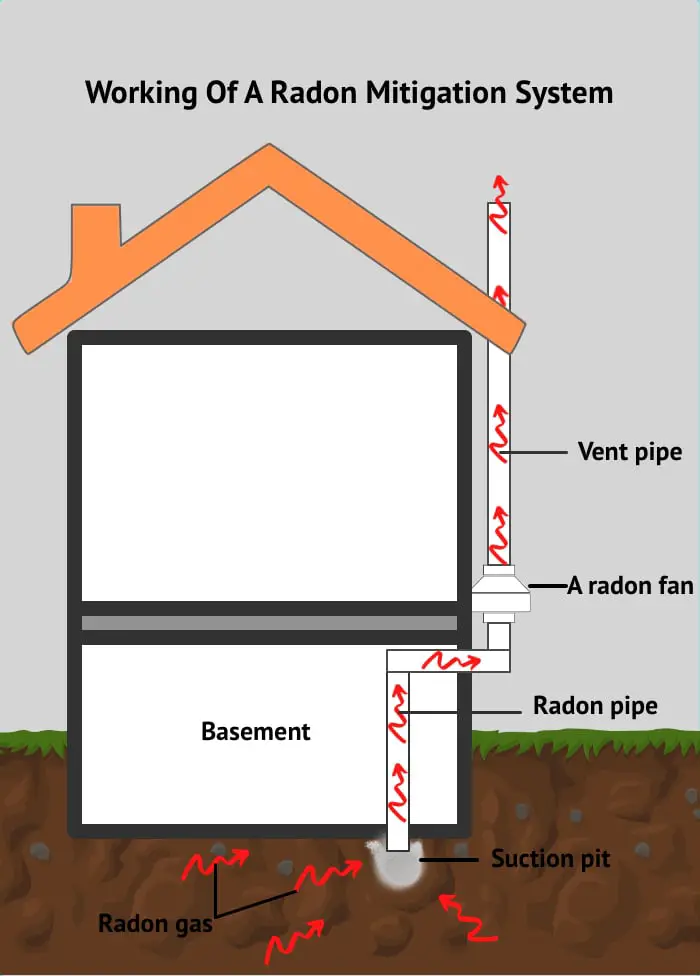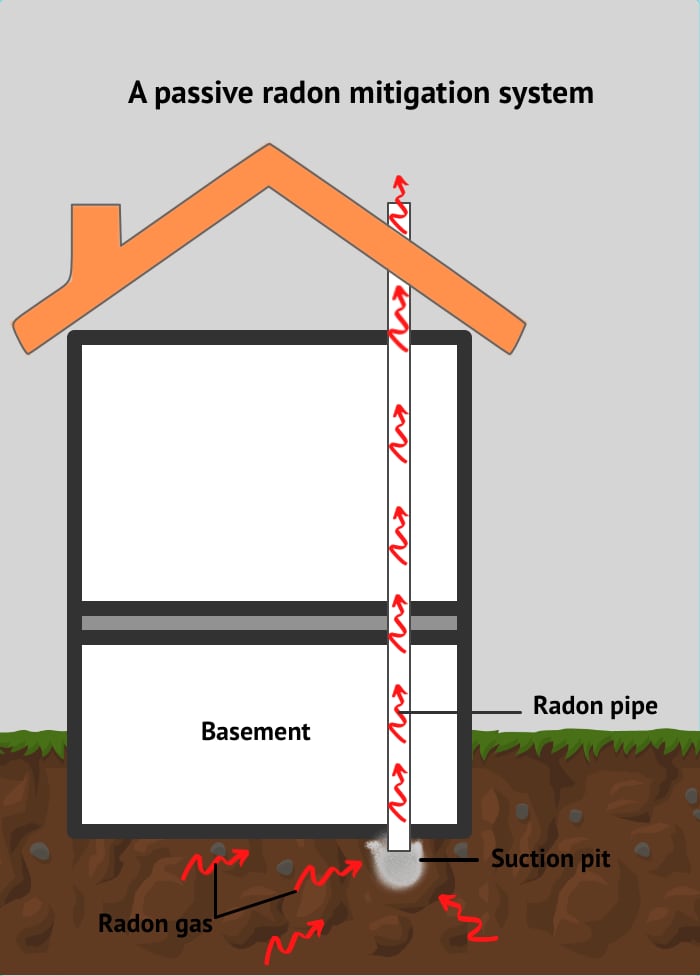A radon mitigation system is any system that reduces the high radon levels in a home by either preventing radon gas entering a home or by venting it once inside. There are different types of radon mitigation systems. However, they are broadly classified into active and passive systems.
An active radon mitigation system uses a fan to remove radon. The fan creates a negative pressure zone under the house. Radon gas gets collected in this zone and is vented out through the system’s ducts forced by the fan’s suction. A passive system reduces radon levels using natural air pressure differences.
Active mitigation systems are the most effective in reducing radon levels, especially when they are above the safe limits stated by EPA (Environmental Protection Agency), which is 4pCi/L.
How does a radon mitigation system work
Radon gas enters a house through the cracks in the walls and floor of its basement. A radon mitigation system removes radon either by force or by natural ventilation. This can be achieved either after or before the gas enters the house. Eliminating radon before it enters the house is the better method of these two. This is done by using an active mitigation system. Such a system has three main parts. They are;
- A radon fan
- Ventilation ducts
- A suction pit
If the basement of the house is a finished one, a suction point is made by digging a hole, usually 4 inches in diameter, into it. The hole should be deep enough to reach the soil. The soil is further dug to create a small pit.
A radon pipe, made of PVC or ABS, is inserted into this pit. It is then ducted to the outside or into the garage through the wall of the basement. A radon fan is installed there. The exhaust of the radon fan is connected to a long duct that reaches above the roofline.
When the fan is run, it sucks the air from the pit under the basement. This creates negative pressure in that point, which draws in all the radon gas from under the house. The radon gas collected in this pit is sucked out by the fan and vented through its exhaust pipe.

In addition to sucking the air from under the basement, the mitigation system also draws in some of the air in the basement as well. This helps to reduce the moisture levels in the basement.
If the house’s basement is not a finished one, or if the house has a crawl space instead of the basement, the floor is sealed with plastic sheets, which prevent the radon gas from entering the conditioned space. The radon pipe coming from the radon fan is inserted through these plastic sheets and sealed. When the fan is run, it will draw the radon-filled air from beneath the sheets, thus preventing his dangerous gas from entering the house. This gas is then vented outside at roof level through appropriate ducts.
A radon system needs to be run 24/7 to lower the radon concentration in a house. If the suction is stopped, the gas will seep back into the house, elevating its radon levels within hours.
A passive radon system works by using the same components as an active mitigation system but without the radon fan. It uses a PVC ducting that is inserted into the basement floor to vent the radon gas from under the house. In passive mitigation, the radon is outed due to the pressure difference between the outside and below the house. Its vent pipe offers a path of least resistance for the radon gas to escape.

This method is very effective if you already have low radon levels.
You can also pressurize the basement by using a fan. The positive pressure built by the fan prevents radon from entering the basement. But this method works only if the basement is completely sealed off from the other living areas of the house.
Does radon mitigation really work
Radon mitigation systems can reduce the radon levels in a house by up to 99%, depending on which system you use. Active mitigation systems achieve the most reduction, from 50 to 99%, while that achieved by passive systems vary.
The effectiveness of active systems depends on the size of the basement, compactness of the soil under the house, and various other factors while that of a passive system varies depending on the radon levels inside the home and the weather conditions outside.
Basement pressurization method can reduce radon levels from 50 to 90%.
How long does it take to mitigate a house with radon?
On average it takes 48 hours for a mitigation system to reduce radon levels in a house. This time depends on the initial radon levels in the house and the type of mitigation system installed.
If the initial radon readings were very high, it might take more time to get the radon gas out of the house. For houses with low but above safe radon levels, mitigation can be achieved within a few hours.
Is a house safe after radon mitigation
A house is safe from radon health hazards if the radon mitigation system is able to bring down its radon levels to below 4pCi/L. However, as there are no safe levels for radon, it is best to mitigate radon as much as possible.
You can do a radon test after 48 hours of running the mitigation system. Check if the levels are reduced and are within the safe limits, if not contact your installer and modify the current system. It is advised to use a continuous monitoring system like Airthings (Amazon link) to constantly monitor the radon levels in your home. The levels of radon in a house can vary round the year, and even round the clock, so it is important to make sure that these levels are within the safe limits throughout the year.
How to know if my radon system is working?
Radon mitigation systems come with a u-tube manometer installed. This manometer indicates the suction created by the fan. If one tube of the manometer shows an elevated level of liquid, it means that the radon fan is working. If the levels in both tubes are the same, it means that your radon system is broken.

